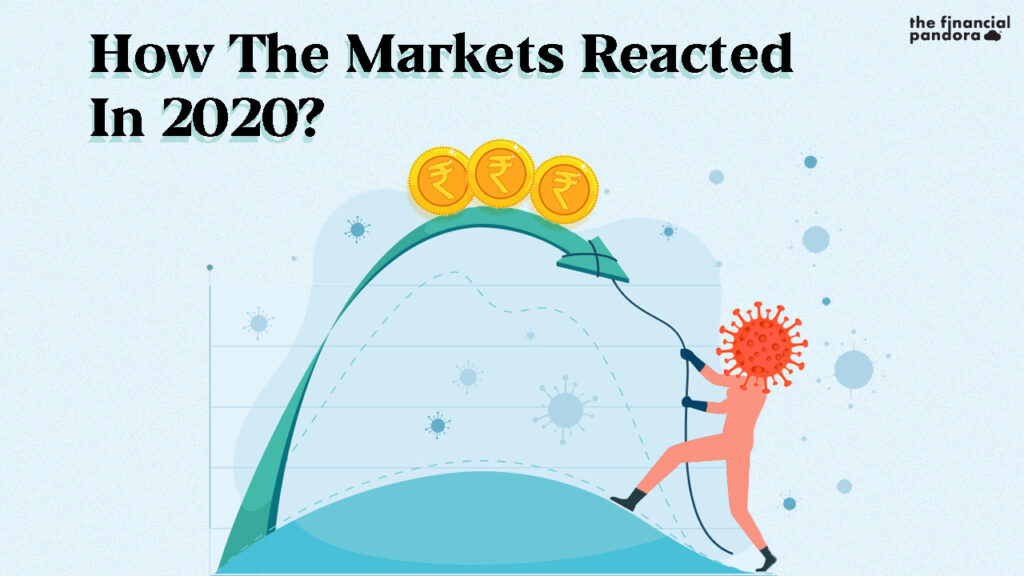It is no secret that the year 2020 has been the most adventurous roller-coaster ride for everyone. The Indian equity market is no exception. From the record highs at the start of the year to record levels of decline in a day and bouncing back again, this year on Dalal street has been a ride, not for the fainthearted.
In this article, we will re-visit the major events that took place and have a look at how it affected the Indian stock market.
Events that shook the markets in 2020:
Amid rising tensions between India and its neighbours, China announced that it has developed its own ‘Mother of All Bombs’. Tensions also escalated in the Middle East as Iran’s most powerful military commander, Gen. Qasem Soleimani was killed by a US airstrike in Baghdad, Iraq.
The initial report of a new virus outbreak, COVID-19, in China started to emerge in January but, it did not have much impact on Dalal street as markets quickly rebounded.
Back at home, Union Budget 2020-21 is just around the corner and the market indicators are not too optimistic. The sentiment continued as the budget was announced and fell short of expectations. The Supreme Court did not favour the Telco’s in the review petition against the order of AGR dues. The placing of the moratorium on Yes Bank by RBI was a blow to confidence in the banking sector.
By mid-February, the number of cases started to increase and it was becoming clear that the new virus has not been contained in China and could be a pandemic. The WHO confirmed the doubts of the market and the global markets began the downward spiral as the uncertainty and fear rises.
FIIs pulled the trigger and started to aggressively remove funds out of the country, making Gold, once again, the safest asset to rely upon in uncertain times. Surprisingly DIIs remained the net buyers till February end.
Although there were enough shocks in the first 2 months of the year, the biggest one was yet to come in March. On 24th March, Prime Minister Modi announced a 21 days nationwide lockdown, forcing over a billion people to stay inside their homes.
The Sensex, expecting the same, had its biggest drop of 3,934 points or over 13% on March, 23rd. The immediate rebound of 2,476 points (the biggest jump ever) came on April 7th as the government assured the measures to increase liquidity and direct aid to the affected industries and the US federal reserve vowed to do the same.
Meanwhile, the chairman of Reliance Industries, Mukesh Ambani was on a mission to raise funds for his new venture. The result was astonishing as he closed deals with the likes of Facebook, Google, Silver Lake, Mubadala, and PIF of Saudi Arabia to sell a minority stake in Jio Platforms and raised around $25 Billion as a result.
In May, Prime Minister announced a package of Rs. 20 Lakh Crores to combat the downside effects of the virus and revive the economy. After the initial boost, it failed to impress as expected. The US, on the other hand, had started its measures to provide trillions of dollars in liquidity and FIIs & FPIs started to pour large funds back into India (over $20 billion this year).
In the coming months, markets continued to move upwards with minor corrections. The news of the second wave of virus in Europe and the USA affected markets for a few days only to see it rebound in the next week. In November, ‘the vaccine cheer’ and a close win of Biden in the US election helped propel the global markets to new highs as did the Indian markets.
Other significant events included Oil prices crashing as the demand drops significantly and oil futures turning negative for the first time in history. The prices stabilized once there was a consensus to reduce production among oil-exporting countries.
The Economy vs. Dalal Street – The rising dichotomy:
The recovery has started to look more like a V-shaped curve at least for the stock market as it rallies to new highs. But, the reality behind the numbers is that the economy is struggling more than ever to keep up with the expectations.
The Indian economy tanked by ~24% in the first quarter of FY 2020-21 and another 7.5% in the second quarter. The unemployment rate reached over 23% in April of 2020. With these numbers, there is no reason that the stock market should rise, right? Well, not really.
The stock market i.e. indices Sensex and Nifty are no longer a true representation of the state of the economy of the country. It represents the largest companies in the country (Top 30 for Sensex and 50 for Nifty). These are the companies that can survive almost any crisis (or that is what is believed). And, these are the companies that benefit the most when the government decides to increase liquidity through monetary policy and stimulus packages and provide loans at cheaper costs. Hence, they become more valuable.
Another reason for the rally is the large quantum of incoming funds of FIIs and FPIs after initial outflow in March.
Along with inflow from foreign institutions, domestically, more people than ever have demat accounts. 68 Lakh new demat accounts were opened during the course of the pandemic which is a record in itself. This means people saw this crash as a buying opportunity, thereby contributing to increase in the prices of stocks.
Recent IPOs like Burger King, Route Mobile, Happiest Minds, etc. benefitted from the increased applications as they were able to do a successful listing in India even during the pandemic.
The reality, as harsh as it is, is that during the crisis, the big gets bigger and small businesses are crunched.
Overall performance:
The Sensex closed the calendar year 2020 at 47,751 after reaching high of 47,897 with an impressive Year-To-Date returns of 15.75% while Nifty closed at 13,981 after breaching 14,000 with returns of 14.90%.
Sensex closed the year with a PE of 33.40 as compared to 26.01 on December 31st, 2019. This means that stocks have become more expensive for every rupee of earnings earned by the companies in the index. Only time will tell if the level of expectation can be met by the future earnings.
Outlook for 2021 – What to look forward to?
If the movements in 2020 are any indication, 2021 will surely be a great year to watch. A few things to keep an eye on:
- The new strain of coronavirus is spreading across the globe may lead to another cycle of lockdown as it is said to be 70% more transmissible.
- New monetary and trade policies of the that Biden administration will introduce, can affect Indian companies.
- Farmer’s protesting across the nation against new farm laws introduced by the government.
- Recovery of worst-hit sectors especially in the aviation and hospitality industry.
- In Union Budget 2021, it is reported that we will see a significant increase in government spending to revive the economy.
- Moody’s Investors Service has revised its GDP projection for India in 2020-21 to a 10.6% contraction.
Do let us know the list of things you are keeping a watch on.
This post was written in collaboration with Asif Yahiya Sukri LLP. Asif Yahiya Sukri LLP provides unparalleled personalized financial services to a broad range of clients across different geographical locations. With presence in the USA, India and the MENA region, they ensure that all of your financial decisions are made carefully and with your best interests in mind. They are innovators who understand what goes into building companies.
You can also reach out to them on info@aysasia.com
Follow Us @




